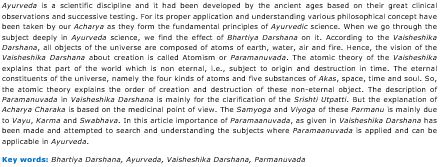Concept of Parmanuvada and its Utility
Keywords:
Bhartiya Darshana, Ayurveda, Vaisheshika Darshana, ParmanuvadaAbstract
Ayurveda is a scientific discipline and it had been developed by the ancient ages based on their great clinical observations and successive testing. For its proper application and understanding various philosophical concept have been taken by our Acharya as they form the fundamental principles of Ayurvedic science. When we go through the subject deeply in Ayurveda science, we find the effect of Bhartiya Darshana on it. According to the Vaisheshika Darshana, all objects of the universe are composed of atoms of earth, water, air and fire. Hence, the vision of the Vaisheshika Darshana about creation is called Atomism or Paramanuvada. The atomic theory of the Vaisheshika explains that part of the world which is non eternal, i.e., subject to origin and destruction in time. The eternal constituents of the universe, namely the four kinds of atoms and five substances of Akas, space, time and soul. So, the atomic theory explains the order of creation and destruction of these non-eternal object. The description of Paramanuvada in Vaisheshika Darshana is mainly for the clarification of the Srishti Utpatti. But the explanation of Acharya Charaka is based on the medicinal point of view. The Samyoga and Viyoga of these Parmanu is mainly due to Vayu, Karma and Swabhava. In this article importance of Paramaanuvada, as given in Vaisheshika Darshana has been made and attempted to search and understanding the subjects where Paramaanuvada is applied and can be applicable in Ayurveda.
Downloads
References
Prof.Dr.Yogesh Chandra Mishra, Basic Principles of Ayurveda Padartha Vijnana. Chaukhambha Sanskrit Sansthan Varanasi, 2016, Chapter-16, Page-472.
Prof.Dr.Yogesh Chandra Mishra, Basic Principles of Ayurveda Padartha Vijnana. Chaukhambha Sanskrit Sansthan Varanasi, 2016, Chapter-16, Page-472.
Dr. Smt. Shailaja Srivastava, Sharngadhara Samhita of Acharya Sharangadhara Jiwanprada Hindi Commentary, Chaukhambha Orientalia Varanasi, 2013. Page-6
Iswar krishna Gupta, Samkhya Karika, Sahitya Bhandar Ratirama Publisher, Meratha, Edition 1999, Sutra-24-25, Page-126.
Prof.Dr.Yogesh Chandra Mishra, Basic Principles of Ayurveda Padartha Vijnana. Chaukhambha Sanskrit Sansthan Varanasi,2016, Chapter-16, Page-473.
Dr. Smt. Shailaja Srivastava, Sharngadhara Samhita of Acharya Sharangadhara Jiwanprada Hindi Commentary, Chaukhambha Orientalia Varanasi, 2013. Page-6-7
Dr.P.V.Tewari, Charaka Samhita English Translation Of Text With Ayurveda Dipika Commentary Of Chakrapani Datta Purvardha Chaukhambha Vishvabharati Varanasi, 2018, Sharira Sthana Chapter-7,Shloka-17,Page-461.
Pandit Kashinatha Sashtri, Dr.Gorakhnatha Chaturvedi, Charaka Samhita Part-1, Edition 2011 Vidyotini Hindi Commentary Chaukhambha Vishvabharati Varanasi, 2011, Sharira Sthana Chapter-1,Shloka-19,Page-804.
Prof.Dr.Yogesh Chandra Mishra, Basic Principles of Ayurveda Padartha Vijnana. Chaukhambha Sanskrit Sansthan Varanasi,2016, Chapter-16, Page-474-475.















